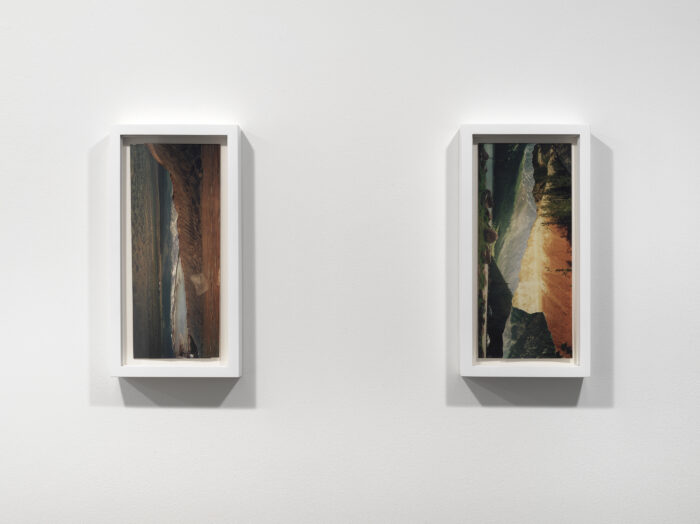
In his New York solo debut, artist Pete Moran presents ten discreet objects installed with unique sincerity and acute attention. One gets the sense Moran sat a long time with these mostly found objects before assembling them into carefully considered arrangements. The objects are commonplace and unpretentious, suggestive of American rural life and its specular image. The combinations are clever and calculated, but also allow for eccentric thoughts, clueing us in to the artist’s surrealist wit and keenness for alliteration.
The sculpture ‘I Know, I Know, I Know’, from which this exhibition takes its name, includes three working hairdryers hanging from the gallery’s high ceiling. Propelled by their occasional bursts of air, the appliances swing from their cords like a pendulum clock gone awry. The work is a crowd-pleaser, but not a spectacle. Each appliance tangles and untangles around the other, arousing intrigue with their audible humming, while retaining a melancholic air. While watching the sculpture turn and pivot, I mouthed the words “I know, I know, I know” until the title slipped unconsciously into “I blow, I blow, I blow”, the knowing and the blowing combined. One constantly shifts their stance around the sculpture, causing the body to reconsider its relation to the exhibition’s many spatial and semiotic knots.

Barley recognizable at first, ‘Given the Situation’ is a singular plaster nose cast directly from the artist’s face, its tip nailed to the wall. Despite the object’s matter-of-factness, the suggestive title solicits further inquiry. What is the given situation? Is the situation something worth turning away from, something causing the nose to withdraw and hide? Or is the situation less a story of discipline and punishment and more a question of structure. Perhaps the given situation is the artwork’s structural support, the gallery’s white wall, which is a convention not without its history and circumstance. If so, the nose addresses this situation by effacing it directly.

Two large collages,‘Skies # 36’ and ‘Skies # 72’, lean vertically against an adjacent wall. The collages are made from pictures of the American landscape which serve as metonyms for the country and its desired wholeness. As though performing surgery upon this myth, Moran cuts the landscapes along their horizons, separating the ground from the sky. He then reattaches these zones with their supposed equivalent: a ground with a ground, a sky with a sky. Each part looks to identify with its mirror-image. The collages are scanned and printed as framed photographs, flattening the paper’s physical edge and creating an ontological ambiguity between collage and photograph. Like Narcissus held captive by his own reflection, these folded landscapes suggest a latent narcissism, one embedded within the act of looking westward towards an imaginary object.

Whether hanging, leaning or pointing, the pieces are always gesturing to another place. ’Dead, Or Worse than Dead’ does exactly this. Suggestive of a signpost plucked from an old Western, the sculpture consists of six plastic duck decoys stacked one over the other. The decoys are held together by a long pole driven through their heads and into a cast-iron skillet, which serves as the sculpture’s base. The title makes you think, what is worse than death? I watched a father and child pose for a selfie in front of ‘Dead, Or Worse than Dead’ with their fingers drawn like pistols. I wondered, did the sculpture solicit this pointing given its unconscious resemblance to a signpost? Or does the pointing suggest a more deeply rooted impulse? We learn at a young age to point at what we wish to claim and maybe even kill. Mindful of this impulse the sculpture deflects the aim, leading our attention elsewhere. Whether a mirror or a decoy, Moran shows how these objects are not devices for self-knowledge, but instruments of misdirection.
The exhibition’s press release, titled ‘Metal Man’, is an artwork in itself, presenting the reader with a story that reflects the conceptual drives of Moran’s work. The story is simple: one man sells to another man a collection of metal objects. With each item comes a little more information about the buyer: his marriage, his debt, the loss of a child, a life lived piece by piece. The text reveals how our most intimate desires and fears are somehow carried by, or within, the most mundane objects, causing the reader to consider the ways worth and value are determined. During their exchange, the men share the same refrain: “I know”. But their knowledge is limited. And maybe that’s the point. We know almost nothing, but this fragile utterance “I know”, said impulsively, is a white lie that underwrites so many exchanges. What is most interesting about the word ‘know’ is it carries its own negative expression: no. The know and the no share the same edge. As if hiding unconsciously within the fabric of knowledge, the ‘no’ stages its doubt from within.
Pete Moran’s ‘I Know I Know I Know’ at Cathouse Proper @ 524 Projects
extended to Feb 16
Review by David Whelan
David Whelan is an artist and writer based in New York. He has an MFA in Painting and Printmaking from Yale University School of Art and is a former Director of the Institute of Studio Studies in Auvillar, France. Whelan is the recipient of the Toby Devan Lewis Fellowship and a Fulbright Scholarship. His writing has been published in PreCog Magazine and Effects Journal.
